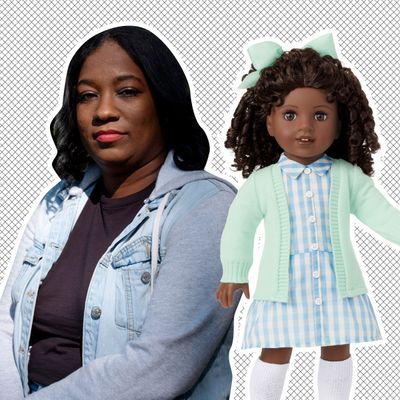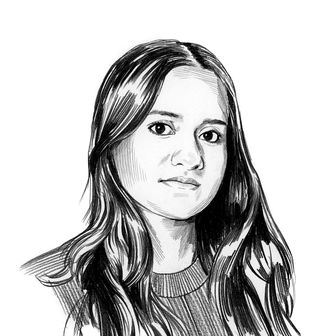
Brit Bennett never thought she’d actually create an American Girl doll, but you could say it’s a reality she’s manifested for years. “Gonna passive-aggressively tweet my way to this American Girl doll deal, just watch me,” the author wrote in a since-deleted tweet from 2016, after the franchise added a ’60s doll to its fold of historical characters. When an ’80s doll joined the fray two years ago, Bennett persisted: “Give us a Black American Girl doll set in the ’90s,” she tweeted in 2020, adding, “and please let me write it.”
To Bennett’s surprise, the powers that be at American Girl reached out to her. It was too soon for a ’90s doll, but they wanted to collaborate. Bennett had always been interested in the Harlem Renaissance, so she came up with Claudie—an 8-year-old Black girl growing up in 1922. Claudie, whose series debuted in August, is the franchise’s third Black historical doll, following Connie Porter’s Addie, who was set in the Civil War era, and Denise Lewis Patrick’s Melody, the ’60s doll released in 2016. The daughter of a baker and a reporter, Claudie lives with her little brother and dog, Dizzy Dot, in a boardinghouse full of tenants who use their art to scrape together back rent after an eviction notice hits. But unlike the many artists of the time period, Claudie has no idea what her talent is, or whether she has any at all. “I wanted to take the Harlem Renaissance, which we view as this period of an outpouring of talent, but also think about the regular people who were around living their lives, who were maybe not the flashy artists,” Bennett says.
Bennett made her fiction debut in 2016 with The Mothers, which chronicles a young Black woman grieving her mother’s suicide who returns to her Southern California community following a family emergency. Her second novel, The Vanishing Half, about two Black sisters whose lives splinter when one abandons her old life to pass as a white woman, is currently being adapted by HBO, with Issa Rae joining Bennett as an executive producer. Claudie’s story is Bennett’s first foray into children’s fiction. “I’ve always wanted to write for young readers at some point in my career, but I didn’t know what form it would take,” she says. “It’s a little bit of a responsibility for Black authors, because there are so few books about Black children.”
The Cut spoke to Bennett about what it’s like to create an American Girl doll.
Claudie’s journey started with your 2020 tweet, but your relationship with American Girl dolls goes back much farther. What was your experience with the dolls growing up?
Like most millennials, I was really into American Girl dolls. I used to check out American Girl books from the library, and my sister and I owned some of the Addy books. We were really into the lore. I read a lot of historical fiction when I was a kid, but there was something particular about American Girls that was more immersive. At the time, Addy was the only Black doll, so she was the one I had. Her series was very important to me. It probably was the series that introduced me to the idea of slavery.
Before you wrote Claudie’s story, you spoke with Connie Porter, who wrote the Addy series. What was that like?
I spoke to her at the beginning of the process when I was still considering whether or not to do it. It was only a few months after The Vanishing Half came out, and I wasn’t sure if I had the energy or the ability to write a book for children at that moment. It was the first time I’d spoken to an author who wrote one of the books I read as a kid, so that was a surreal moment. I remember loving Addy and the books, but she told me about the pushback she got at the time. She told me there were some Black readers who were like, why are you talking about this, and who had a feeling of shame about this traumatic part of history being presented to children. That was 30-something years ago, and it was interesting to hear her say how much it meant to her, at the end of the day, that she did it. It was a trailblazing series of books that meant so much and still means a lot to young readers. She told me, maybe 30 years from now there will be a woman who comes up to you saying she loved the book you wrote. That’s what tugged my heartstrings and made me want to do it.
I was touched that Connie made it to my book launch in New York and I got to meet her in person. It felt like a celebration for her as well. It’s important for me to see an author from her generation receive that type of love. To see all these millennials mobbing her at the store, because she wrote something that meant something to them as kids, was really cool.
How did you decide to set Claudie in the Harlem Renaissance?
It was very involved. Writing about a time period from 100 years ago presents challenges about what sources are available. Through American Girl, we had a board of historians and scholars that weighed in on those aspects of the story. I had a researcher who helped me if I had questions: What would this have looked like? Would she have access to this? There were moments where my story ideas informed where we went with the research, and other moments where the research informed where I went with the story. I remember one of the historians mentioning the importance of community pools in Harlem at the time, as a gathering space, so I wanted to have a scene set at a pool.
You usually don’t write children’s fiction. What was it like to switch modes?
It was challenging in ways I didn’t expect. If you’re used to writing for adults, you might have younger characters, but they’re not really engines of the story. With Claudie it was important to make sure there wasn’t an adult who swoops in at the last minute and fixes everything for her. You’re with her, centering her consciousness, which might sound obvious but wasn’t something that came naturally to me. I’ve never written from the perspective of a child as young as Claudie. I’ve done some coming-of-age, teenager scenes, but never for someone quite as young. Stylistically it was different too. There were moments when my editor said, an 8-year-old will read this literally, so you need to find a different way to say it.
The largest thing was the fact that, in these books, you’re teaching history to children. I wanted to be honest and truthful and accurate to the history and the experience of this 8-year-old Black child in 1922. But at the same time, you want it to be entertaining for kids. It’s a doll, and you want there to be that sense of playfulness, that fantasy and that joy. I wanted it to feel organic and truthful without disregarding the fact that the function of these books — or at least the pleasure I got from them as a child — was that I didn’t feel like someone was teaching me. I felt like I was just experiencing a story.
There’s a wunderkind trope in a lot of books for young readers, where the protagonist is preternaturally talented or gifted. Although Claudie is growing up in an era of creativity, I liked that she struggles to find what she’s good at. Did you ever have similar doubts, as a child or as an adult?
That was one of the reasons I wrote the story in the direction I did: the trope of the “special boy” with the talent or gift. You know he’s the main character because he’s special in some way. It applies to someone of any age or gender, and not just in children’s fiction. Growing up, I loved reading and writing; I felt I had some writing talent, but never felt it was a slam dunk or guaranteed that I’d write a book someday. Like Claudie, I remember seeing people with talents more visible than writing. Writing is something you often do alone, that you work on for years before someone sees it. Even if you’re good at it, it’s not this showy thing like singing or dancing. In college I’d work on my novel alone in my dorm room, surrounded by people with this very obvious glowing talent everyone praised them for. When I came out with my book, it came out of nowhere. Nobody knew I was working on it. So I can relate to the feeling Claudie has, that everyone around you is talented and you’re toiling in obscurity for a bit. I wanted to look at the ways all the people we don’t look at as artists, like her parents, are able to create art in their lives.
What has the response to Claudie felt like? So many people are excited.
It’s been fun to see the pictures people are posting with Claudie. I’ve given her to my friends with kids, so they’ve started sending me pictures of their kids with her, which is really sweet. There was such an outpouring of love the day I announced the book was out. People were blowing up my Instagram and excited about it. It’s gratifying to see the book and the doll out in the world, and to have this doll, who is very cute, come from my brain and now be something I can hold. It’s different from the typical experience of writing a novel and holding it, because I created this character and now she’s sitting on my bookshelf.


